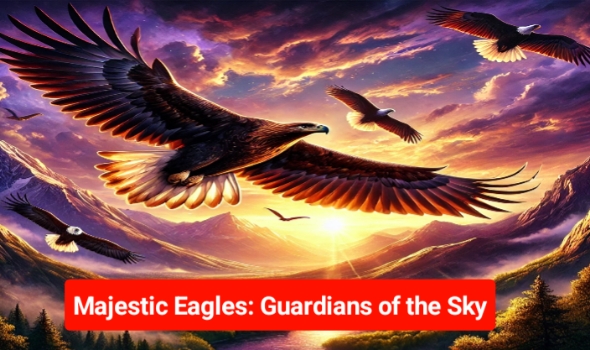Majestic Eagles: Guardians of the Sky – A 1000-Word Insight into the World of Eagles, Eagles belong to the family Accipitridae, which includes other birds of prey such as hawks and kites.
Majestic Eagles: Guardians of the Sky
Eagles are some of the most iconic and revered birds in the animal kingdom. With their sharp vision, powerful build, and regal presence, these raptors are celebrated as symbols of strength, freedom, and vision across various cultures worldwide. This article delves into the fascinating world of eagles, exploring their biology, habitats, significance, conservation efforts, and the myths surrounding these majestic birds.
Biology and Characteristics
Eagles belong to the family Accipitridae, which includes other birds of prey such as hawks and kites. There are around 60 species of eagles, distributed mainly across Africa, Eurasia, and the Americas. Renowned for their incredible eyesight, eagles can spot prey from several kilometers away, thanks to a retina packed with photoreceptors and a large, curved cornea.
One of the most striking features of an eagle is its powerful beak. Adapted for tearing flesh, the beak is curved and robust, a perfect tool for their carnivorous diet. Their talons are equally formidable, designed for capturing and immobilizing prey. Eagles’ wingspans can range from 1.8 meters (for smaller species) to over 2.5 meters, as seen in the Philippine eagle or the harpy eagle.
Habitats and Distribution
Eagles inhabit a diverse range of ecosystems, from dense forests and towering mountains to arid deserts and wetlands. While some species, like the bald eagle, thrive near large water bodies, feeding primarily on fish, others, such as the golden eagle, are more versatile and can adapt to a variety of habitats.
Africa hosts the greatest diversity of eagles, including species like the martial eagle and the crowned eagle. In North America, the bald eagle holds a special place as the national bird of the United States. Asia and Australia also feature unique eagle species, such as the Philippine eagle and the wedge-tailed eagle.
Cultural Significance
Eagles have held symbolic significance in human societies for centuries. In ancient Roman and Greek mythology, eagles were seen as messengers of the gods, embodying power and divine authority. The eagle was a sacred bird to Zeus, the king of the Greek gods, and to Jupiter in Roman mythology.
In more recent times, eagles have become national symbols. The bald eagle, for instance, has been the emblem of the United States since 1782, representing freedom, courage, and strength. Similarly, many Native American tribes regard the eagle as a sacred creature, believing its feathers hold spiritual power and using them in rituals and ceremonies.
Diet and Hunting Strategies
Eagles are apex predators, occupying the top of the food chain. Their diet primarily consists of fish, mammals, birds, and reptiles, depending on the species and habitat. The bald eagle, for example, is well-known for its fishing prowess, often swooping down to snatch fish from water surfaces. On the other hand, the golden eagle hunts a variety of prey, including hares, foxes, and even young deer.
Eagles are known for their remarkable hunting strategies. They often soar high above their territory, scanning the ground with their acute vision. Once they spot prey, they dive at incredible speeds, striking with precision and force. This hunting technique is not only effective but also demonstrates their dominance in the avian world.
Conservation Status and Threats
Despite their commanding presence in the wild, many eagle species face significant threats, primarily due to human activities. Habitat destruction, pollution, and hunting have led to declining populations of several eagle species. The Philippine eagle, for instance, is critically endangered due to deforestation in its native habitat. Similarly, the steppe eagle is listed as endangered due to habitat loss and poisoning from pesticides.
Conservation efforts are crucial to ensuring the survival of these magnificent birds. Organizations like the International Union for Conservation of Nature (IUCN) and the World Wildlife Fund (WWF) have been working to protect eagle habitats and raise awareness about their plight. Rehabilitation centers and breeding programs also play a vital role in conserving eagle populations.
Success Stories in Conservation
Not all eagle conservation stories are bleak. The bald eagle, once on the brink of extinction in the United States due to hunting and the use of the pesticide DDT, has made a remarkable comeback. Thanks to conservation efforts and the banning of DDT in 1972, bald eagle populations have rebounded, leading to their removal from the endangered species list in 2007.
Similar efforts are being undertaken for other species. In the Philippines, conservationists are working tirelessly to protect the critically endangered Philippine eagle through habitat preservation and public education campaigns. These initiatives serve as a testament to the positive impact of concerted conservation efforts.
Eagles in Modern Media and Literature
Eagles continue to inspire awe and admiration in modern culture. They are frequently featured in literature, films, and artwork, symbolizing freedom and nobility. From the majestic imagery of eagles soaring above mountains to their use as mascots and emblems, these birds hold a special place in the human imagination.
In popular media, eagles have been depicted as wise and powerful creatures. Their flight, often filmed in slow motion, is a visual metaphor for liberty and transcendence. Documentaries like Planet Earth have further highlighted the beauty and resilience of eagles, bringing their world closer to human audiences.
The Mystique of Eagles in Folklore
Eagles have been the subject of numerous myths and legends. In Native American folklore, the eagle is often seen as a connection to the divine, a messenger between the spiritual and earthly realms. In Norse mythology, the eagle was considered a symbol of wisdom and was associated with the god Odin.
Some cultures believe that eagles possess the power to protect against evil spirits. Their feathers are often used in ceremonial attire, embodying the qualities of courage and strength. These myths not only highlight the cultural importance of eagles but also underscore their role as symbols of hope and resilience.
The Role of Technology in Studying Eagles
Modern technology has revolutionized the study and conservation of eagles. Satellite tracking, for instance, allows researchers to monitor eagle migration patterns and behaviors. This data is crucial for understanding their ecological needs and implementing effective conservation strategies.
Drones and high-resolution cameras have also enabled scientists to observe eagles in their natural habitats without causing disturbances. These tools provide insights into their breeding habits, diet, and interactions with other species, contributing to a deeper understanding of these incredible birds.
A Future for Eagles
Eagles, with their commanding presence and ecological significance, deserve our admiration and protection. As apex predators, they play a vital role in maintaining the balance of ecosystems. Protecting their habitats and ensuring their survival is not just about preserving a species; it is about safeguarding the natural world that supports all life on Earth.
Through continued conservation efforts, education, and the use of technology, we can ensure that future generations will also have the privilege of witnessing the majesty of eagles in the wild. Their flight, a symbol of freedom and resilience, reminds us of the beauty and interconnectedness of the natural world.
Eagles, indeed, are more than just birds of prey. They are symbols of what humanity can achieve when we aim high and work tirelessly to protect the treasures of our planet.
How did you like the information given in our article today, please tell us in the comment section and for more such posts, follow our page the News House, thank you


